Baseline Assessment of Poultry Production, Pharmaceutical Product Use, and Related Challenges on Commercial Poultry Flocks in Kano and Oyo States of Nigeria
Abstract
1. Introduction
2. Materials and Methods
2.1. Ethics
2.2. Study Population and Area
2.3. Study Approach
2.4. Data Collection
2.5. Data Analysis
3. Results
3.1. Farm Characteristics and Respondent Demographics
3.2. Poultry Production
3.2.1. Products Obtained from the Farm and Sold to Generate Revenue
3.2.2. Products Perceived to Generate the Highest Revenue
3.2.3. Secondary Activities Performed on the Farm to Generate Revenue
3.3. Farm Costs and Revenue in the Previous Production Cycle
3.3.1. Number of Chicks on Farm
3.3.2. Cost of One-Day Old Chicks
3.3.3. Number of Chicks Hatched at Hatchery on Farm
3.3.4. Source of Day-Old Chicks (DOCs) for Farms with No Hatchery
3.3.5. Production Information on Broiler Birds Reared on Farm
3.3.6. Production Information on Layer Birds Reared on Farm
3.3.7. Estimated Farm Management Costs
3.3.8. Estimated Vaccines Cost
3.4. Pharmaceutical Products Used on the Farm in Previous Production Cycle
3.4.1. Antibiotics Administered
3.4.2. Provision of Supplementary Additives in Bird Feed
3.4.3. Source of Pharmaceutical Products Used
3.4.4. Source of Vaccines, Advice on Vaccination Protocols and Person Performing Vaccinations
3.4.5. Challenges Experienced in Relation to Pharmaceutical Products
3.4.6. Challenges Experienced in Relation to Vaccines
4. Discussion
4.1. Poultry Production
4.1.1. Hatcheries
4.1.2. Poultry Products
4.2. Pharmaceutical Products
4.2.1. Antibiotics
4.2.2. Use of Medicines in Poultry Feed
4.2.3. Challenges
4.2.4. Access to Veterinary Services
4.3. Study Limitations
5. Conclusions
Supplementary Materials
Author Contributions
Funding
Institutional Review Board Statement
Informed Consent Statement
Data Availability Statement
Acknowledgments
Conflicts of Interest
References
- Adene, D.F.; Oguntade, A.E. The Structure and Importance of the Commercial and Village Based Poultry Industry in Nigeria; FAO: Rome, Italy, 2006.
- OIE. Animal Population Data. World Organisation for Animal Health. 2017. Available online: https://www.oie.int/wahis_2/public/wahid.php/Countryinformation/Animalpopulation/ (accessed on 14 April 2021).
- Jatau, I.D.; Lawal, I.A.; Kwaga, J.K.P.; Tomley, F.M.; Blake, D.P.; Nok, A.J. Three Operational Taxonomic Units of Eimeria Are Common in Nigerian Chickens and May Undermine Effective Molecular Diagnosis of Coccidiosis. BMC Vet. Res. 2016, 12, 86. [Google Scholar] [CrossRef]
- Liverpool-Tasie, L.S.O.; Omonona, B.; Sanou, A.; Ogunleye, W.; Padilla, S.; Reardon, T. Growth and Transformation of Food Systems in Africa: Evidence from the Poultry Value Chain in Nigeria. Niger. J. Agric. Econ. 2017, 7, 1–15. [Google Scholar] [CrossRef]
- Adebowale, O.O.; Adeyemo, O.K.; Awoyomi, O.; Dada, R.; Adebowale, O. Antibiotic Use and Practices in Commercial Poultry Laying Hens in Ogun State Nigeria. Rev. D’élevage Médecine Vétérinaire Pays Trop. 2016, 69, 41–45. [Google Scholar] [CrossRef]
- Oluwasile, B.; Agbaje, M.; Ojo, O.; Dipeolu, M. Antibiotic Usage Pattern in Selected Poultry Farms in Ogun State. Sokoto J. Vet. Sci. 2014, 12, 45–50. [Google Scholar] [CrossRef]
- Al-Mustapha, A.I.; Adetunji, V.O.; Heikinheimo, A. Risk Perceptions of Antibiotic Usage and Resistance: A Cross-Sectional Survey of Poultry Farmers in Kwara State, Nigeria. Antibiotics 2020, 9, 378. [Google Scholar] [CrossRef]
- Ekiri, A.B.; Armson, B.; Adebowale, K.; Endacott, I.; Galipo, E.; Alafiatayo, R.; Horton, D.L.; Ogwuche, A.; Bankole, O.N.; Galal, H.M.; et al. Evaluating Disease Threats to Sustainable Poultry Production in Africa: Newcastle Disease, Infectious Bursal Disease, and Avian Infectious Bronchitis in Commercial Poultry Flocks in Kano and Oyo States, Nigeria. Front. Vet. Sci. 2021, 8, 730159. [Google Scholar] [CrossRef] [PubMed]
- Ekiri, A.B.; Endacott, I.C.; Galipo, E.; Alafiatayo, R.; Adebowale, K.; Dineva, M.; Wakawa, A.; Ogwuche, A.; Maikai, B.-V.; Armson, B. Poultry Health, Management Practices and Challenges Faced on Commercial Poultry Farms in Oyo and Kano States of Nigeria. Front. Vet. Sci. 2021. [Google Scholar] [CrossRef]
- Ameji, O.; Abdu, P.; Sa’idu, L.; Isa-Ochepa, M. Knowledge of Poultry Diseases, Biosecurity and Husbandry Practices among Stakeholders in Poultry Production in Kogi State, Nigeria. Sokoto J. Vet. Sci. 2012, 10, 26–31. [Google Scholar] [CrossRef][Green Version]
- Maduka, C.V.; Igbokwe, I.O.; Atsanda, N.N. Appraisal of Chicken Production with Associated Biosecurity Practices in Commercial Poultry Farms Located in Jos, Nigeria. Scientifica 2016, 2016. [Google Scholar] [CrossRef]
- Adisa, B.O.; Akinkunmi, J.A. Assessing Participation of Women in Poultry Production as a Sustainable Livelihood Choice in Oyo State, Nigeria. Int. J. Plant Anim. Environ. Sci. 2012, 2, 73–82. [Google Scholar]
- Assured Food Standards. Red Tractor Certified Standards—Chicken Standards: Hatchery; Red Tractor Assurance: London, UK, 2019. [Google Scholar]
- Salami, A.; Kamara, A.B.; Brixiova, Z. Smallholder Agriculture in East Africa: Trends, Constraints and Opportunities; African Development Bank Group: Tunis, Tunisia, 2010. [CrossRef]
- Khan, A.; Cheri, L. An Examination of Poverty as the Foundation of Crisis in Northern Nigeria. Insight Afr. 2016, 8, 59–71. [Google Scholar] [CrossRef]
- Adesokan, H.K.; Akanbi, I.O.; Akanbi, I.M.; Obaweda, R.A. Pattern of Antimicrobial Usage in Livestock Animals in South-Western Nigeria: The Need for Alternative Plans. Onderstepoort J. Vet. Res. 2015, 82, 816. [Google Scholar] [CrossRef] [PubMed]
- Ogwuche, A.; Ekiri, A.B.; Endacott, I.; Maikai, B.-V.; Idoga, E.S.; Alafiatayo, R.; Cook, A.J.C. Antibiotic Use Practices of Veterinarians and Para-Veterinarians and the Implications for Antibiotic Stewardship in Nigeria. J. S. Afr. Vet. Assoc. 2021, 92, a2120. [Google Scholar] [CrossRef]
- Ventola, L.C. The Antibiotic Resistance Crisis. Part 1: Causes and Threats. Pharm. Ther. 2015, 40, 277–283. [Google Scholar] [CrossRef]
- Oloso, N.O.; Fagbo, S.; Garbati, M.; Olonitola, S.O.; Awosanya, E.J.; Aworh, M.K.; Adamu, H.; Odetokun, I.A.; Fasina, F.O. Antimicrobial Resistance in Food Animals and the Environment in Nigeria: A Review. Int. J. Environ. Res. Public Health 2018, 15, 1284. [Google Scholar] [CrossRef]
- Aibinu, I.E.; Peters, R.F.; Amisu, K.O.; Adesida, S.A.; Ojo, M.O.; Odugbemi, T. Multidrug Resistance in E. Coli O157 Strains and the Public Health Implication. J. Am. Sci. 2007, 3, 22–33. [Google Scholar]
- Erwin, S.; Foster, D.M.; Jacob, M.E.; Papich, M.G.; Lanzas, C. The Effect of Enrofloxacin on Enteric Escherichia Coli: Fitting a Mathematical Model to in Vivo Data. PLoS ONE 2020, 15, e0228138. [Google Scholar] [CrossRef] [PubMed]
- World Health Organization. Critically Important Antimicrobials for Human Medicine, 6th ed.; World Health Organization: Geneva, Switzerland, 2019.
- Federal Ministry of Agriculture and Rural Development Environment and Health (FMARD). National Action Plan for Antimicrobial Resistance 2017–2022. Available online: https://ncdc.gov.ng/themes/common/docs/%0Aprotocols/77_1511368219.pdf%0A (accessed on 6 September 2021).
- Vermeulen, B.; De Backer, P.; Remon, J.P. Drug Administration to Poultry. Adv. Drug Deliv. Rev. 2002, 54, 795–803. [Google Scholar] [CrossRef]
- Oladipo, F.O.; Bello, O.G.; Daudu, A.K.; Kayode, A.O.; Kareem, O.W.; Olorunfemi, O.D.; Iyilade, A.O. Adoption of Bio-Security Measures against Avian-Influenza Outbreaks among Poultry Farmers in Jigawa State, Nigeria. J. Agric. Ext. 2020, 24, 85–94. [Google Scholar] [CrossRef]
- Umar, H.M.; Ismail, R.; Abdul-Hakim, R. Regional Inequality of Educational Attainment in Nigeria. Br. J. Econ. Manag. Trade 2014, 4, 420–430. [Google Scholar] [CrossRef] [PubMed]
- Fawole, O.P. Poultry Farmers’ Utilization of Information in Lagelu Local Government Area, Oyo State of Nigeria. Int. J. Poult. Sci. 2006, 5, 499–501. [Google Scholar]
- Grimm, P. Social Desirability Bias. In Wiley International Encyclopaedia of Marketing; Wiley Online Library, John Wiley & Sons: Hoboken, NJ, USA, 2010. [Google Scholar] [CrossRef]
- Eriksen, S.; Lutz, C.; Tadesse, G. Social Desirability, Opportunism and Actual Support for Farmers’ Market Organisations in Ethiopia. J. Dev. Stud. 2018, 54, 343–358. [Google Scholar] [CrossRef]
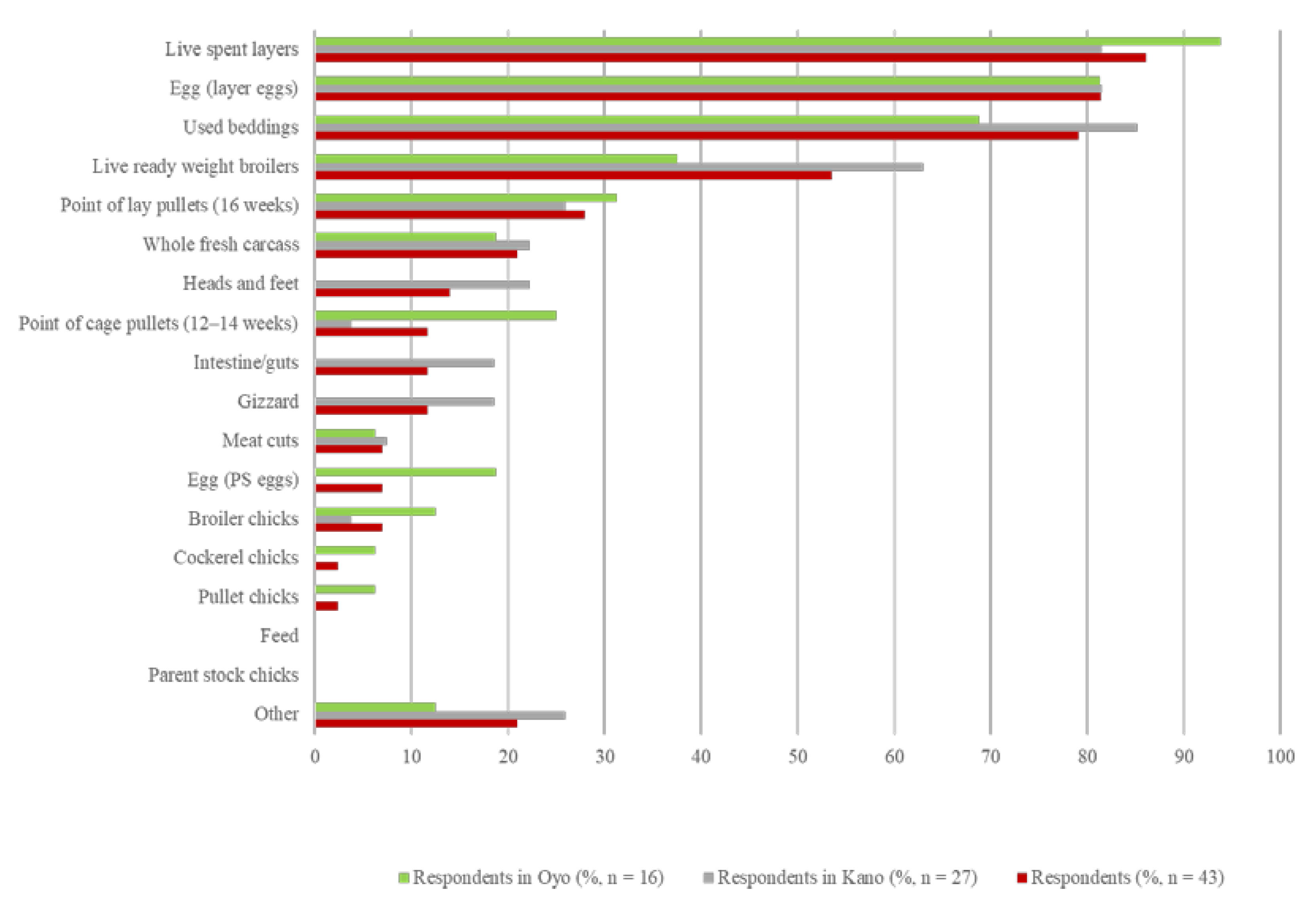
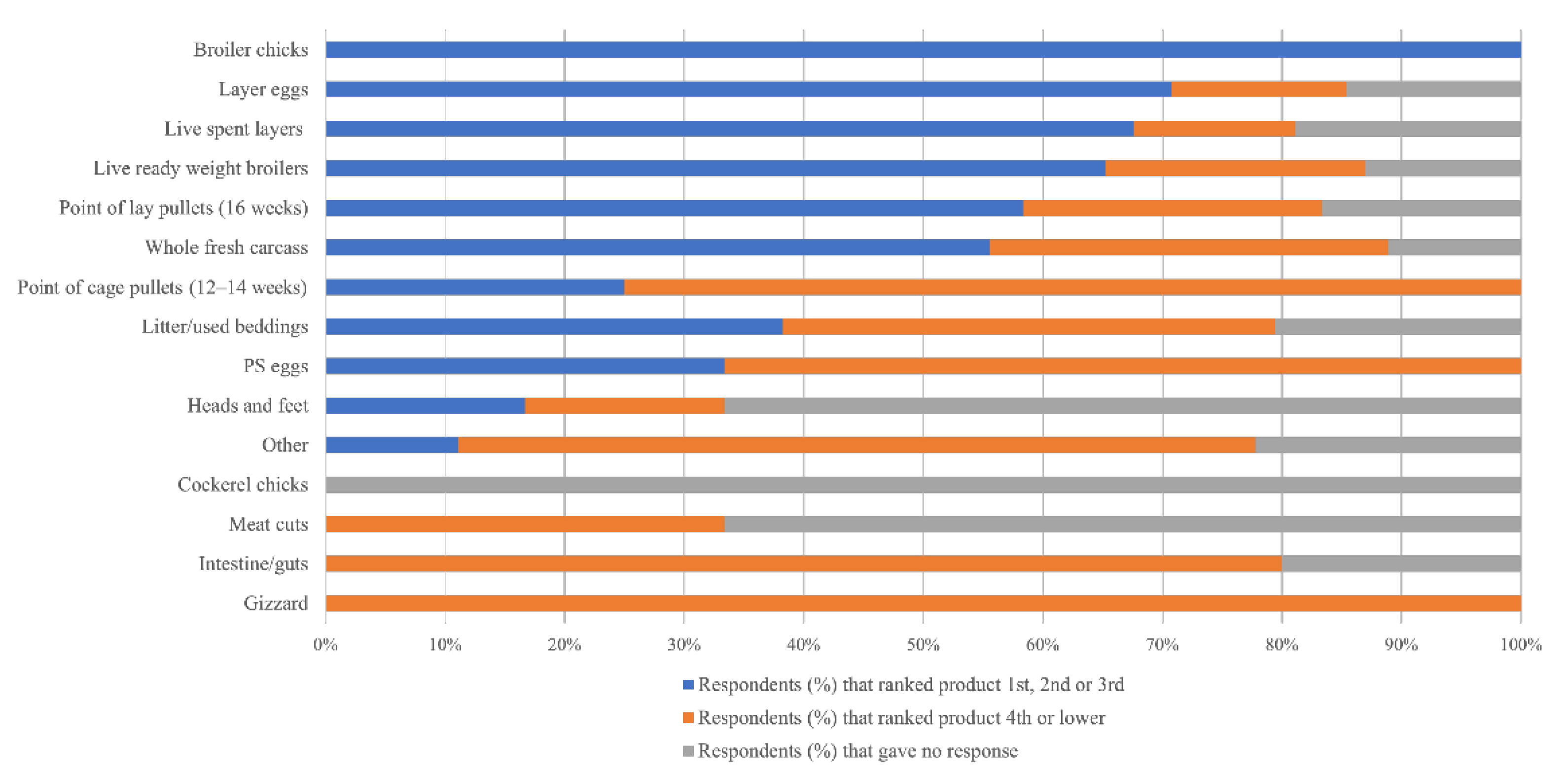
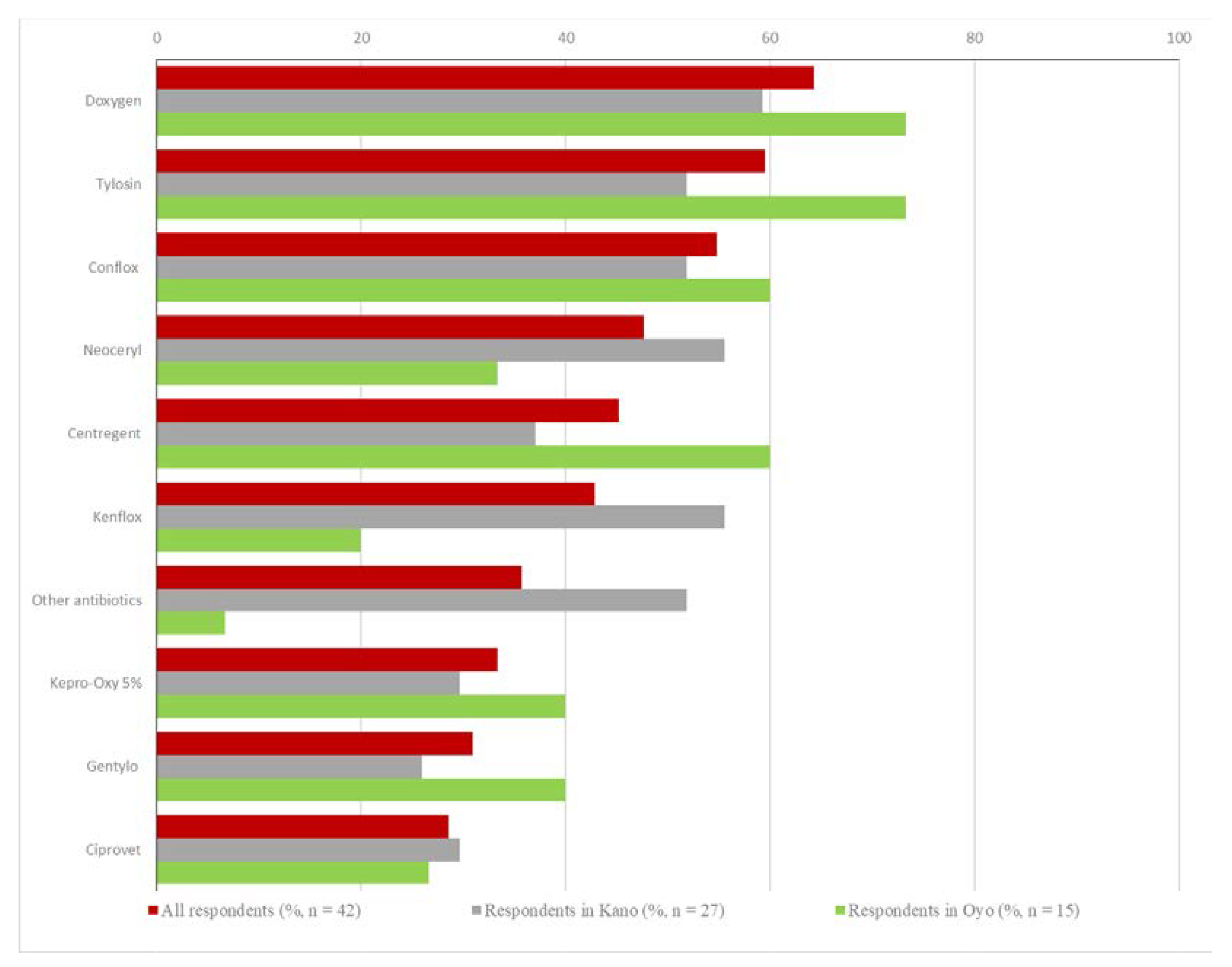


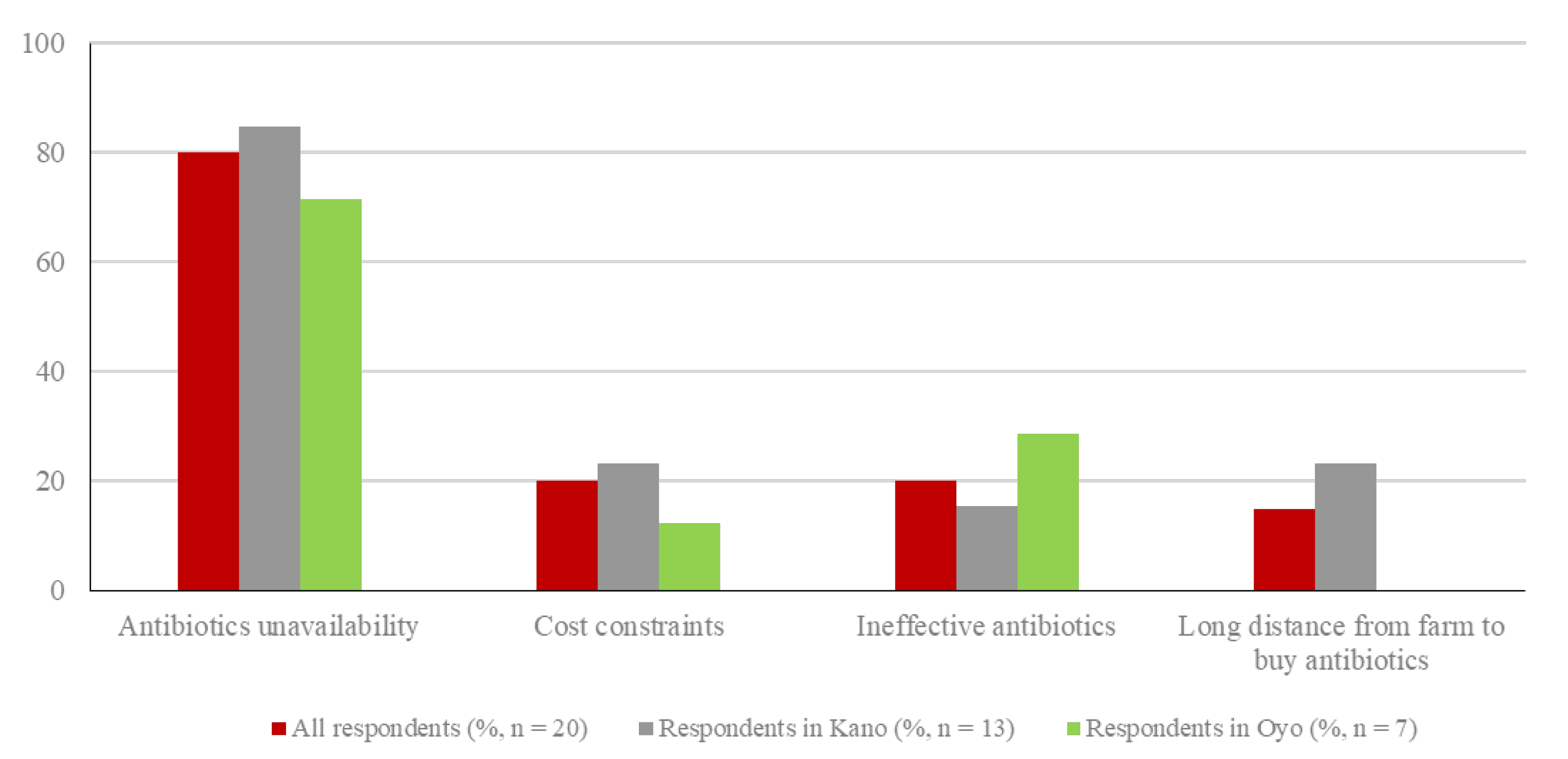
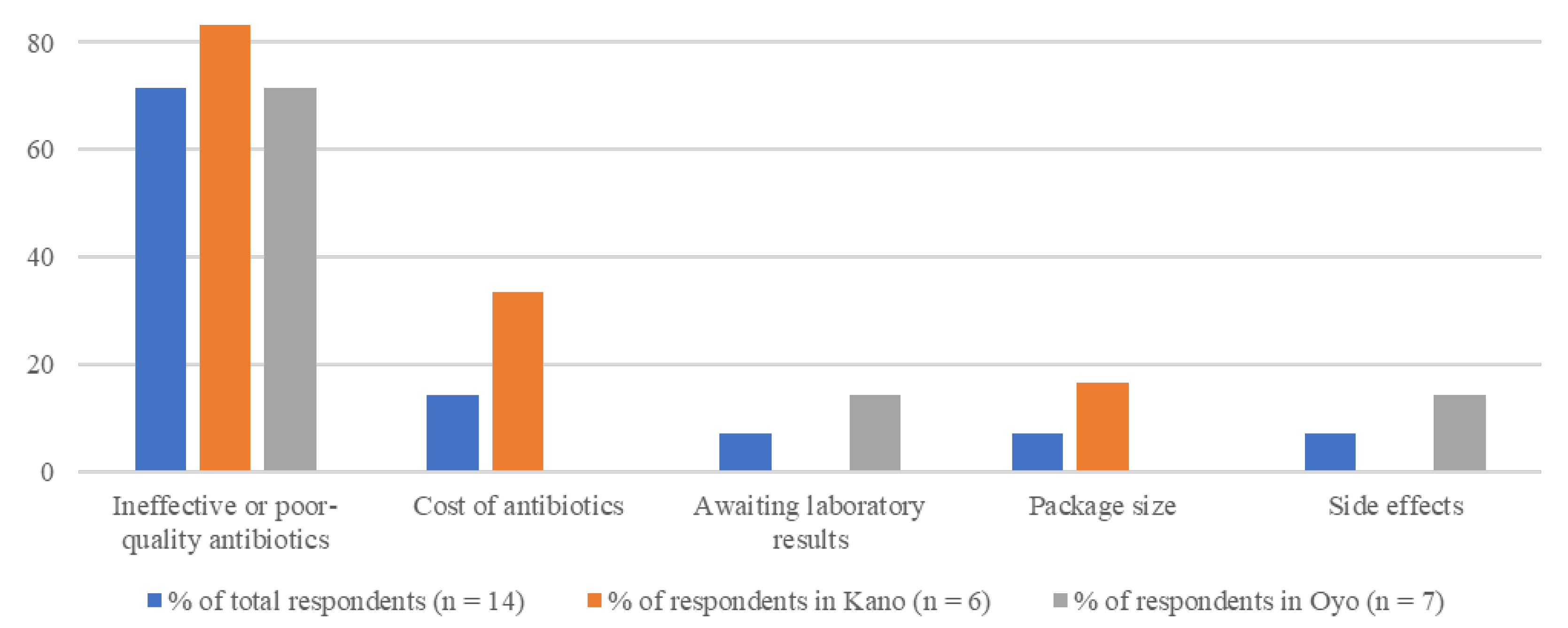
| Information on Broiler Birds | State | n | Mean | SD | Median | Min | Max |
|---|---|---|---|---|---|---|---|
| Average number of broiler birds reached slaughter weight | Total | 13 | 546.3 | 871.4 | 200.0 | 35.0 | 2940.0 |
| Oyo | 3 | 1637.3 | 1470.4 | 1929.0 | 43.0 | 2940.0 | |
| Kano | 10 | 219.0 | 127.5 | 200.0 | 35.0 | 450.0 | |
| Average slaughter age (weeks) | Total | 16 | 6.8 | 1.3 | 6.5 | 5.0 | 10.0 |
| Oyo | 4 | 7.0 | 2.0 | 6.0 | 6.0 | 10.0 | |
| Kano | 12 | 6.7 | 1.1 | 7.0 | 5.0 | 8.0 | |
| Average slaughter weight (kg) | Total | 12 | 2.0 | 1.3 | 1.8 | 1.2 | 6.0 |
| Oyo | 4 | 2.1 | 0.3 | 2.0 | 1.8 | 2.5 | |
| Kano | 8 | 2.0 | 1.6 | 1.4 | 1.2 | 6.0 | |
| Average price for a broiler bird at ready slaughter weight (NGN, USD) | Total (NGN) | 16 | 1510.6 | 810.4 | 1300.0 | 530.0 | 3500.0 |
| (USD) | 3.7 | 2.0 | 3.2 | 1.3 | 8.5 | ||
| Oyo (NGN) | 6 | 1961.7 | 1201.1 | 1850.0 | 530.0 | 3500.0 | |
| (USD) | 4.8 | 2.9 | 4.5 | 1.3 | 8.5 | ||
| Kano (NGN) | 10 | 1240.0 | 275.7 | 1300.0 | 800.0 | 1700.0 | |
| (USD) | 3.0 | 0.7 | 3.2 | 1.9 | 4.1 | ||
| Average number of bird mortalities on farm | Total | 16 | 380.6 | 888.8 | 50.0 | 7.0 | 2800.0 |
| Oyo | 5 | 92.6 | 63.7 | 85.0 | 7.0 | 180.0 | |
| Kano | 11 | 511.6 | 1059.7 | 30.0 | 10.0 | 2800.0 |
| Information on Layer Birds | State | n | Mean | SD | Median | Min | Max |
|---|---|---|---|---|---|---|---|
| Number of layer birds reaching maturity | Total | 30 | 5958.6 | 11,255.7 | 2797.0 | 90.0 | 56,000.0 |
| Oyo | 12 | 4694.0 | 4120.6 | 3210.0 | 160.0 | 11,800.0 | |
| Kano | 18 | 6801.7 | 14,256.6 | 992.5 | 90.0 | 56,000.0 | |
| Length of production cycle (weeks) | Total | 31 | 78.7 | 22.2 | 80.0 | 20.0 | 130.0 |
| Oyo | 13 | 88.5 | 12.7 | 88.0 | 63.0 | 114.0 | |
| Kano | 18 | 71.7 | 25.1 | 72.0 | 20.0 | 130.0 | |
| Average price per crate of eggs sold (NGN, USD) | Total (NGN) | 32 | 783.4 | 98.2 | 800.0 | 400.0 | 900.0 |
| (USD) | 1.9 | 0.2 | 1.9 | 1.0 | 2.2 | ||
| Oyo (NGN) | 13 | 793.9 | 35.2 | 800.0 | 750.0 | 800.0 | |
| (USD) | 1.9 | 0.1 | 1.9 | 1.8 | 1.9 | ||
| Kano (NGN) | 19 | 776.3 | 125.1 | 800.0 | 400.0 | 900.0 | |
| (USD) | 1.9 | 0.3 | 1.9 | 1.0 | 2.2 | ||
| Number of spent-layer or off-layer birds sold for slaughter | Total | 32 | 5381.4 | 9175.1 | 2440.0 | 80.0 | 51,000.0 |
| Oyo | 13 | 5722.3 | 4668.2 | 3750.0 | 800.0 | 14,250.0 | |
| Kano | 19 | 5148.2 | 11,415.4 | 2100.0 | 80.0 | 51,000.0 | |
| Average price for spent-layer or off-layer birds sold for slaughter at end of cycle (NGN, USD) | Total (NGN) | 33 | 1185.8 | 172.7 | 1200.0 | 800.0 | 1500.0 |
| (USD) | 2.9 | 0.4 | 2.9 | 1.9 | 3.6 | ||
| Oyo (NGN) | 13 | 1296.2 | 114.5 | 1250.0 | 1100.0 | 1500.0 | |
| (USD) | 3.2 | 0.3 | 3.0 | 2.7 | 3.6 | ||
| Kano (NGN) | 20 | 1114.0 | 167.9 | 1150.0 | 800.0 | 1350.0 | |
| (USD) | 2.7 | 0.4 | 2.8 | 1.9 | 3.3 | ||
| Average number of bird mortalities occurred | Total | 32 | 848.1 | 1278.0 | 290.0 | 7.0 | 5000.0 |
| Oyo | 13 | 696.9 | 1116.2 | 278.0 | 7.0 | 3900.0 | |
| Kano | 19 | 951.6 | 1398.0 | 340.0 | 10.0 | 5000.0 |
| Estimated Costs (NGN, | State | n | Mean | SD | Median | Min | Max |
|---|---|---|---|---|---|---|---|
| USD) | |||||||
| Feeding broiler birds | Total (NGN) | 11 | 522,913.6 | 562,704.6 | 260,000.0 | 32,000.0 | 1,650,000.0 |
| (USD) | 1271.1 | 1367.8 | 632.0 | 77.8 | 4010.7 | ||
| Oyo (NGN) | 4 | 783,200.0 | 731,249.1 | 725,400.0 | 32,000.0 | 1,650,000.0 | |
| (USD) | 1903.8 | 1777.5 | 1763.3 | 77.8 | 4010.7 | ||
| Kano (NGN) | 7 | 374,178.6 | 435,189.2 | 190,000.0 | 65,000.0 | 1,200,000.0 | |
| (USD) | 909.5 | 1057.8 | 461.8 | 158.0 | 2916.9 | ||
| Feeding layer birds | Total (NGN) | 11 | 9,570,499.5 | 14,360,347.2 | 4,270,500.0 | 1,379,000.0 | 49,275,000.0 |
| (USD) | 23,263.5 | 34,906.4 | 10,380.5 | 3352.0 | 119,775.2 | ||
| Oyo (NGN) | 6 | 7,085,950.0 | 7,495,837.0 | 5,180,850.0 | 1,664,000.0 | 21,600,000.0 | |
| (USD) | 17,224.2 | 18,220.5 | 12,593.4 | 4044.8 | 52,504.2 | ||
| Kano (NGN) | 5 | 12,551,959.0 | 20,614,160.0 | 4,270,500.0 | 1,379,000.0 | 49,275,000.0 | |
| (USD) | 30,510.7 | 50,107.9 | 10,380.5 | 3352.0 | 119,775.2 | ||
| Antibiotic treatment | Total (NGN) | 15 | 328,228.7 | 537,096.0 | 75,000.0 | 30.0 | 1,680,000.0 |
| (USD) | 797.8 | 1305.5 | 182.3 | 0.1 | 4083.7 | ||
| Oyo (NGN) | 5 | 576,280.0 | 640,416.4 | 400,000.0 | 75,000.0 | 1,680,000.0 | |
| (USD) | 1400.8 | 1556.7 | 972.3 | 182.3 | 4083.7 | ||
| Kano (NGN) | 10 | 204,203.0 | 463,873.2 | 30,000.0 | 30.0 | 1,500,000.0 | |
| (USD) | 496.4 | 1127.6 | 72.9 | 0.1 | 3646.1 | ||
| Vaccination programme (vaccines, vet, material for vaccination) | Total (NGN) | 21 | 180,565.2 | 254,765.2 | 56,000.0 | 3200.0 | 750,000.0 |
| (USD) | 438.9 | 619.3 | 136.1 | 7.8 | 1823.1 | ||
| Oyo (NGN) | 6 | 290,920.0 | 346,756.6 | 103,000.0 | 29,520.0 | 750,000.0 | |
| (USD) | 707.2 | 842.9 | 250.4 | 71.8 | 1823.1 | ||
| Kano (NGN) | 15 | 136,423.3 | 206,087.5 | 44,650.0 | 3200.0 | 652,000.0 | |
| (USD) | 331.6 | 500.9 | 108.5 | 7.8 | 1584.8 | ||
| Maintaining biosecurity practices/procedures | Total (NGN) | 32 | 44,210.9 | 80,694.1 | 13,500.0 | 2000.0 | 364,000.0 |
| (USD) | 107.5 | 196.1 | 32.8 | 4.9 | 884.8 | ||
| Oyo (NGN) | 9 | 63,277.8 | 116,185.5 | 15,000.0 | 2500.0 | 364,000.0 | |
| (USD) | 153.8 | 282.4 | 36.5 | 6.1 | 884.8 | ||
| Kano (NGN) | 23 | 36,750.0 | 63,715.7 | 10,250.0 | 2000.0 | 300,000.0 | |
| (USD) | 89.3 | 154.9 | 24.9 | 4.9 | 729.2 | ||
| Litter management | Total (NGN) | 27 | 605,259.3 | 2,139,247.0 | 20,000.0 | 2000.0 | 10,800,000.0 |
| (USD) | 1471.2 | 5200.0 | 48.6 | 4.9 | 26,252.1 | ||
| Oyo (NGN) | 11 | 1,438,091.0 | 3,257,041.0 | 80,000.0 | 10,000.0 | 10,800,000.0 | |
| (USD) | 3495.6 | 7917.1 | 194.5 | 24.3 | 26,252.1 | ||
| Kano (NGN) | 16 | 32,687.5 | 42,903.1 | 12,000.0 | 2000.0 | 156,000.0 | |
| (USD) | 79.5 | 104.3 | 29.2 | 4.9 | 379.2 | ||
| Staff wages and benefits (manager, farm workers, etc) | Total (NGN) | 39 | 1,288,910.0 | 2,867,937.0 | 540,000.0 | 20,000.0 | 18,000,000.0 |
| (USD) | 3133.0 | 6971.2 | 1312.6 | 48.6 | 43,753.5 | ||
| Oyo (NGN) | 12 | 1,119,625.0 | 1,097,514.0 | 600,000.0 | 72,000.0 | 3,240,000.0 | |
| (USD) | 2721.5 | 2667.8 | 1458.5 | 175.0 | 7875.6 | ||
| Kano (NGN) | 27 | 1,364,148.0 | 3,390,063.0 | 384,000.0 | 20,000.0 | 18,000,000.0 | |
| (USD) | 3315.9 | 8240.4 | 933.4 | 48.6 | 43,753.5 |
| Source of Pharmaceutical Products Used on Farm | Total Respondents (n%) (n = 43) 1 | Respondents in Kano (n%) (n = 27) 1 | Respondents in Oyo (n%) (n = 16) 1 |
|---|---|---|---|
| Vet shops | 36 (83.7) | 25 (92.6) | 11 (68.7) |
| Vet pharmaceutical distributors | 8 (18.6) | 4 (14.8) | 4 (25.0) |
| Veterinarian | 2 (4.7) | 0 | 2 (12.5) |
| Other | 0 | 0 | 0 |
| Average Amount of Travel Time from Farm to Source (Vet-Shop, etc.) Where Pharmaceutical Products Are Routinely Purchased/Accessed | Total Respondents (n%) (n = 43) 1 | Respondents in Kano (n%) (n = 27) 1 | Respondents in Oyo (n%) (n = 16) 1 |
|---|---|---|---|
| Less than 60 min | 21 (48.8) | 13 (48.2) | 8 (50.0) |
| Between 1 and 2 h | 18 (41.9) | 12 (44.4) | 6 (37.5) |
| Between 2 and 3 h | 2 (4.7) | 2 (7.4) | 0 |
| >3 h | 1 (2.3) | 0 | 1 (6.3) |
| Not known | 1 (2.3) | 0 | 1 (6.3) |
| Challenge 1 | Total Respondents (n%) (n = 42) 2 | Respondents in Kano (n%) (n = 26) | Respondents in Oyo (n%) (n = 16) |
|---|---|---|---|
| No challenge reported | 10 (23.4) | 4 (15.4) | 6 (37.5) |
| Health issues interfering with schedule | 7 (16.7) | 7 (26.9) | 0 |
| Unavailability of vaccines | 6 (14.3) | 6 (23.1) | 0 |
| Long distance from source | 6 (14.3) | 6 (23.1) | 0 |
| Poor vaccine quality | 4 (9.5) | 3 (11.5) | 1 (6.3) |
| Storage issues (cold chain) | 4 (9.5) | 2 (7.7) | 2 (12.5) |
| Unavailability of vet | 4 (9.5) | 3 (11.5) | 1 (6.3) |
| Ineffective vaccines | 3 (7.2) | 2 (7.7) | 1 (6.3) |
| Negative vaccine effects | 2 (4.8) | 0 | 2 (12.5) |
| Multi-age structure of farm | 2 (4.8) | 0 | 2 (12.5) |
| Difficult handling chickens | 1 (2.4) | 0 | 1 (6.3) |
| High vaccine costs | 1 (2.4) | 1 (3.8) | 0 |
| Vaccine small packages unavailability | 1 (2.4) | 1 (3.8) | 0 |
| Poor water quality affecting vaccineeffectiveness | 1 (2.4) | 0 | 1 (6.3) |
Publisher’s Note: MDPI stays neutral with regard to jurisdictional claims in published maps and institutional affiliations. |
© 2021 by the authors. Licensee MDPI, Basel, Switzerland. This article is an open access article distributed under the terms and conditions of the Creative Commons Attribution (CC BY) license (https://creativecommons.org/licenses/by/4.0/).
Share and Cite
Endacott, I.C.; Galipo, E.; Ekiri, A.B.; Alafiatayo, R.; Adebowale, K.; Dineva, M.; Wakawa, A.; Ogwuche, A.; Maikai, B.-V.; Armson, B.; et al. Baseline Assessment of Poultry Production, Pharmaceutical Product Use, and Related Challenges on Commercial Poultry Flocks in Kano and Oyo States of Nigeria. Vet. Sci. 2021, 8, 315. https://doi.org/10.3390/vetsci8120315
Endacott IC, Galipo E, Ekiri AB, Alafiatayo R, Adebowale K, Dineva M, Wakawa A, Ogwuche A, Maikai B-V, Armson B, et al. Baseline Assessment of Poultry Production, Pharmaceutical Product Use, and Related Challenges on Commercial Poultry Flocks in Kano and Oyo States of Nigeria. Veterinary Sciences. 2021; 8(12):315. https://doi.org/10.3390/vetsci8120315
Chicago/Turabian StyleEndacott, Isabella C., Erika Galipo, Abel B. Ekiri, Ruth Alafiatayo, Kehinde Adebowale, Mariana Dineva, Aliyu Wakawa, Adah Ogwuche, Beatty-Viv Maikai, Bryony Armson, and et al. 2021. "Baseline Assessment of Poultry Production, Pharmaceutical Product Use, and Related Challenges on Commercial Poultry Flocks in Kano and Oyo States of Nigeria" Veterinary Sciences 8, no. 12: 315. https://doi.org/10.3390/vetsci8120315
APA StyleEndacott, I. C., Galipo, E., Ekiri, A. B., Alafiatayo, R., Adebowale, K., Dineva, M., Wakawa, A., Ogwuche, A., Maikai, B.-V., Armson, B., Mijten, E., Varga, G., & Cook, A. J. C. (2021). Baseline Assessment of Poultry Production, Pharmaceutical Product Use, and Related Challenges on Commercial Poultry Flocks in Kano and Oyo States of Nigeria. Veterinary Sciences, 8(12), 315. https://doi.org/10.3390/vetsci8120315






